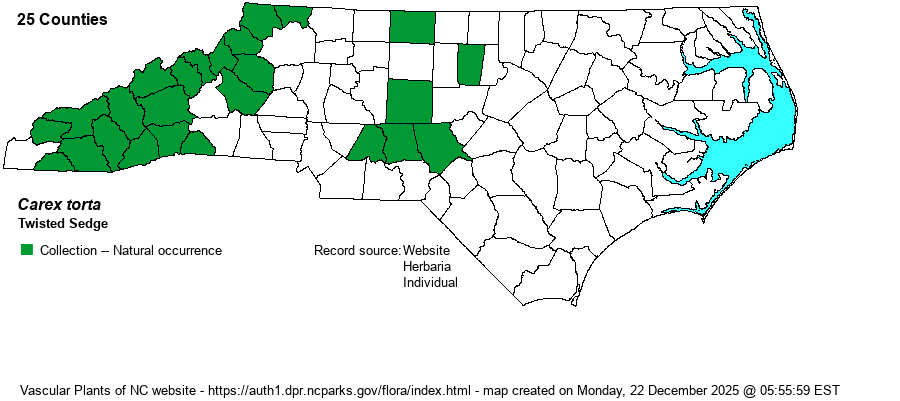| Author | F. Boott ex Tuckerman | |
| Distribution | Mostly the Mountains; disjunct to the lower Piedmont. The gap in the upper Piedmont seems real.
N.S. to Ont. south to northern GA, northern AL, and OK. | |
| Abundance | Frequent in the Mountains, but uncommon in the lower Piedmont. Very rare or rare in between these regions. Individual populations can sometimes have abundant plants. Because of its wide range in the mountains, the website editors feel that S4 is a better rank than S3. | |
| Habitat | Rocky streams, riverbeds, and riverbanks, usually in high energy sections (i.e, rapids, cobble islands). Finding this sedge almost always involves getting to a scenic place. |
| Phenology | Flowering and fruiting April-June. | |
| Identification | Twisted Sedge is generally easy to identify, due to the narrow habitat requirements of rocky, flowing creeks. It grows in dense leafy tufts or patches, with flowering stems (culms) 1-2 feet long and usually leaning over and facing downstream. Female spikes are slender and deep brown to black due the dark perigynia. | |
| Taxonomic Comments | None
The genus Carex is the largest in North America, and among the largest in the world. In temperate and boreal regions, Carex is often the dominant or co-dominant ground layer in many habitats. Seeds (achenes) are valuable food for birds and small mammals, while foliage is used by birds and mammals to make nests and as food by mammals. Species of Carex often look vastly different from one another -- spikes erect vs. drooping, tiny inflorescence vs. whopping, culms leafy vs. naked, perigynia beaked vs. beakless, stems densely bunched vs. single, etc. The genus has been divided into many sections (or groups), based on shared characters; some taxonomists have suggested that these be different genera, but that proves unworkable (so far). All Carex share the feature of a perigynium (an outer covering) which completely surrounds the achene (seed). This covering may fit tightly or loosely (like a small bladder), depending on which group or species. Details of perigynia shape, ornamentation, presence and size of beak, number of striations (or veins) are all important ID features. In recent years Rob Naczi and colleagues have stressed the importance of arrangement of perigynia -- whether spiral (3+ ranks) or distichous (2-ranked) -- and have named a number of new species as well as split off some older synonyms. Therefore, RAB's (1968) key, excellent for its time, can only be used in a general way today. Members of some sections of Carex are difficult to key out (notably Ovales, Laxiflorae, Griseae); this is in part due to variation among individuals of a species, or failings of the key. FNA has drawings of most species and some species may be found in two or more places within a key, to acount for variability. New species to NC, and new to science(!), continue to be found in NC. | |
| Other Common Name(s) | None | |
| State Rank | S3 [S4] | |
| Global Rank | G5 | |
| State Status | | |
| US Status | | |
| USACE-agcp | OBL link |
| USACE-emp | FACW link |

